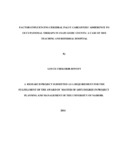| dc.description.abstract | Cerebral palsy is regarded as one of the leading cause of childhood disability
worldwide. If poorly managed it can result in negative health outcomes, permananet
disabilities increased healthcare costs. Little is known about the factors causing
cerebral palsy nonadherence to occupational therapy intervention in UasinGishu
County. The aim of this study was to identify factors influencing caregivers’
adherence to prescribed occupational therapy intervention in Uasin Gishu County and
suggest strategies for reducing their impact. The objectives of the study were: to
examine the effect of travelling distance on adherence to occupational therapy
intervention; to find out the influence of communication between clinician and the
caregivers on adherence to occupational therapy intervention;to examine the impact
of social/economic support on adherence to occpational therapy intervention; the
effect of waiting time on adherence to therapeutic intervention; the effects of parents
knowledge of disease on adherence and importance of treatment. The purpose of the
study was to identify factors influencing caregivers adherence to occupational
therapy in Uasin Gishu County. The study employed qualitative design and purposive
sampling technique in sample and gathering data. The target population were all the
cerebral palsy caregivers bringing their children for occupational therapy at Moi
Teaching and Referral Hospital, and all the occupational therapists working in
occupational therapy outpatient department as key informants. The research
instruments used to collect data included interview schedule guide, focus group
discussions and structured questionnairs for the key informants. With the guide of the
Health Belief Model (HBM) conceptual framework. Data collected was analyzed
using thematic content analysis and descriptive statistics and frequency distribution
tables and Percentages were used to demonstrate the results. The study findings were
realized and conclusion and recommendation were made, which may aid in
improving treatment of cerebral palsy patients. Results indicated that all parents
understood their role in the treatment of cerebral palsy and consequences of not
following the treatment regime. The factors that affect parents attending regular
occupational therapy appointments include: travelling distance and high cost of
treatment; poor social/family support and, poor knowledge of cerebral palsy and its
treatment. The respondet reported that they did not have any problems with waiting
time and and interaction with the clinicians. Conclusion- there is need for the
government to increase awareness through sensitization on, cerebral palsy and its
treatment among the parents and caregivers. There is need to decentralize cerebral
palsy services away from referral hospitals to the people in the community through
outreach programs. | en_US |

